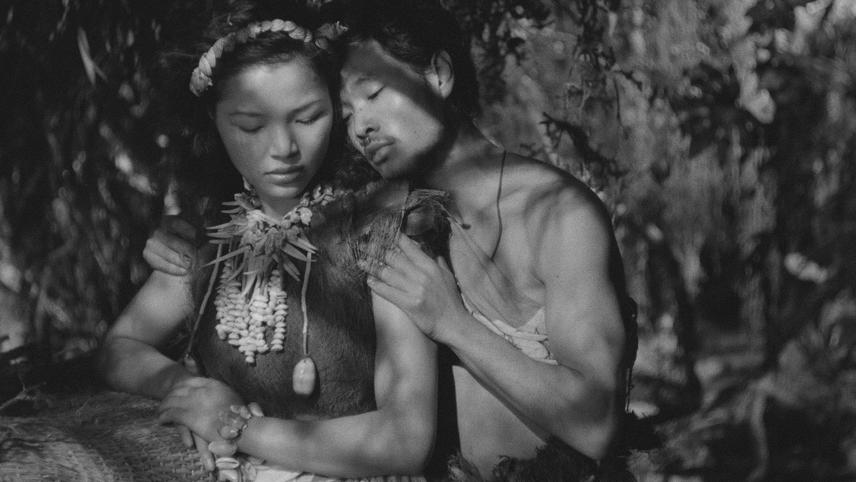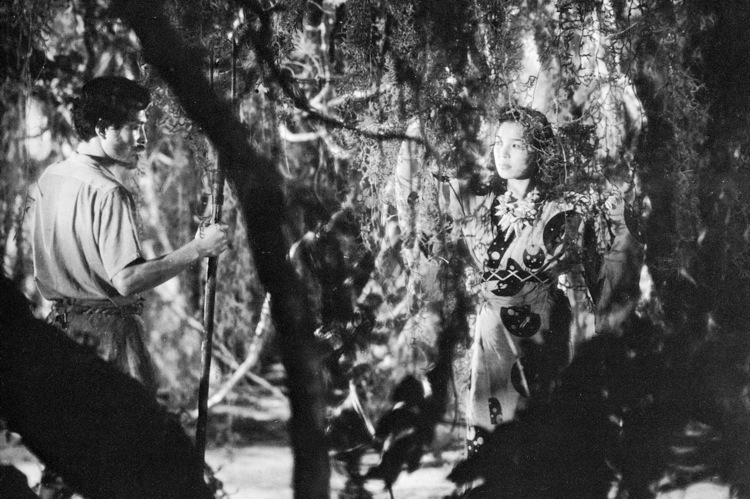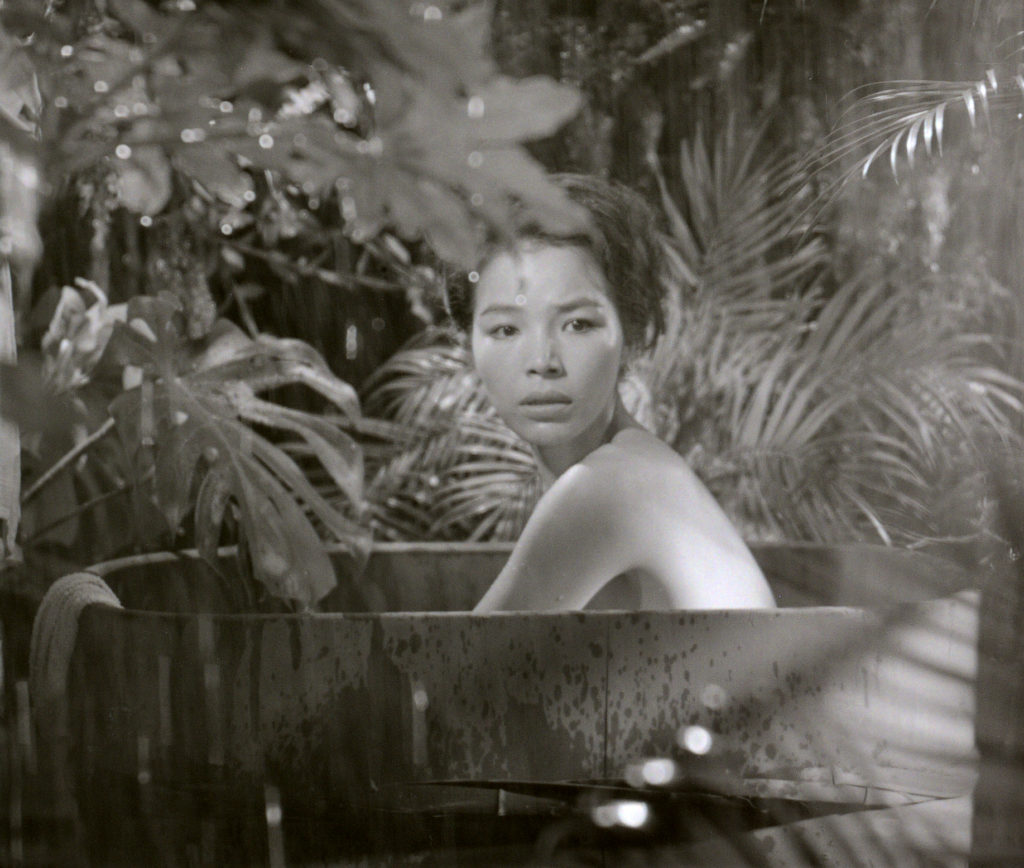Josef von Sternberg Makes a True-Life WWII Tale Sensually and Violently his own
DIRECTED BY JOSEF VON STERNBERG/1953/58
STREET DATE: APRIL 25, 2017/KINO CLASSICS
 As Anatahan washes up on the shores of film buffs as an interesting and unconventional chance to ponder last films and lost films – it being a bit of both for director Josef von Sternberg – it is also a decidedly odd movie on its own individual terms.
As Anatahan washes up on the shores of film buffs as an interesting and unconventional chance to ponder last films and lost films – it being a bit of both for director Josef von Sternberg – it is also a decidedly odd movie on its own individual terms.
When a Japanese warship goes down at sea, the surviving dozen crewmen make their way to the jungle island of the film’s title. The only inhabitants they find are a man tending to an abandoned dwelling, and his apparent wife, a young and beguiling beauty.
Of all the out-of-the-way and unusual places the heretofore rare film and Anatahan goes, the small, uncivilized island of the title is merely one of them, and not even the most notable. A tale wholly entrenched in mania, isolation, loss of self, and the emergence and eventual domination of the primal, Anatahan is, unfortunately for those whom lived some version of it, based on true events.
The focus of its filmmaker’s obsessive attention for years, Anatahan was released in 1953 and then again in 1958, in an alternate cut primarily distinct for featuring newly shot racier footage of the film’s breakout actress, Akemi Negishi. Negishi, debuting here after being discovered by von Sternberg while performing on stage, would go on to make a great many films with luminaries such as Akira Kurosawa (The Lower Depths) and Ishirô Honda (King Kong vs. Godzilla). Per both the storyline and her sensual persona, the actress completely owns the story, both as the central focus of all the men’s raging lust, and as the only character of any perceivable depth.
Clearly the work of a filmmaker with little left to lose, but maintaining ambition, some sort of budget, and a story he simply has to tell, Anatahan is a weirdly engaging wartime Lord of the Flies that’s based on true events.
Negishi, as the young woman Keiko, the sole female on this island of increasing madness, is, per her undeniable good looks, is immediately and appallingly reduced to some sort of sex object du jour, a fleeting reward to be won, had, and had again. Amid the soul crushing monotony of stranded island life, Keiko is the only game in town anyone cares to play.
For a while, she goes along with it. The film’s strangely poetic and ubiquitous narration, provided supposedly by von Sternberg himself, tells us “Keiko had put herself in circulation.” Guns are found on the island, introducing a new level of murderous treachery. Eventually, she reaches her limit. Some men reach their end.

Often referred to as the final film of von Sternberg, Anatahan bears the subtle imprimaturs of an exceptional filmmaker’s twilight work. Von Sternberg, considered one of the most influential and unique filmmakers in cinema history, is known for his intense visual stylings (accused sometimes of being at the expense of his characters). There’s no mistaking a von Sternberg set – the filmmaker never knew a frame of film he couldn’t jam-cram to the nines with all manner of ornately placed clutter, growth, singage, architecture, of whatever else.
Less positively, von Sternberg is also remembered for his thunderous and empirical on-set demeanor. Legend has it he very nearly drove Robert Mitchum to physical violence on the set of 1952’s Macao. Perhaps, though, his most cherished accomplishment is giving the world (but also himself) Marlene Dietrich.
He discovered Dietrich for her breakout hit The Blue Angel, carrying on with her for a great string of films until 1935’s The Devil is a Woman. It was one of the great actor/director collaborations of all time. Seemingly one fell swoop, von Sternberg was no longer sitting pretty. Too many expensive flops, too much infighting and production battles, and frankly, probably too much ego.

Cutting to the end of the filmmaker’s career, Anatahan, aka Ana-at-han, aka The Saga of Anatahan, while being such an anomaly of both the time and in terms of von Sternberg himself, it nonetheless falls right in line with the long list of his tales of men brought down by the charms of a woman. This is pointed out not only in the accompanying visual essay by Tag Gallagher, but also in von Sternberg’s career and life.
Is it too much to think that von Sternberg’s strong pull to this material and the story that inspired it lies heavily in his own life’s story? His is one of powerful conquering vision, success, and cultural dominance, only to lose Dietrich, his status, and his place at the top of the directorial perch. His fiery temper remained, his career isolation grew. By the late 1930s, the name Josef von Sternberg lacked the command it not so long previously demanded. Like the stubborn, stranded Japanese sailers who couldn’t imagine the Empire of Japan voluntarily flying the white flag, perhaps Anatahan is, at least in part, his own admission of how he’d insisted on digging in and holding his ground long after there was any ground to hold.

The 1958 version of Anatahan has been restored in 2K from the original negative, and looks and sounds fantastic. This is stated to be von Sternberg’s preferred cut of the film. Following a brief theatrical re-release, Kino Classics has issued it on Blu-Ray, which also contains the complete original 1953 version of the movie. Although no doubt cutting edge at the time, it is interesting to note how much extra female nudity and near-nudity is permissible in 1958 versus 1953, which has zero. Does this content improve the movie? Judge for yourself by watching a compare/contrast featurette that’s kindly been included on the disc. I’ll vote for the earlier version, even though Negishi’s full-range-of-emotion facial performance in a ’58 bathtub scene would be a shame to lose. Much of the added material simply feels wedged in.
Also on the disc is a new interview with the filmmaker’s son, Nicholas von Sternberg; Some U.S. Navy footage of the original survivors of Anatahan, a couple of trailers for the film, and three minutes of unused (nude) footage, shot for the ’58 version.
Having been completely unfamiliar with this film prior to this Blu-Ray experience, I found Anatahan to be a quite the cinema curio. Clearly the work of a filmmaker with little left to lose, but maintaining ambition, some sort of budget, and a story he simply has to tell, Anatahan is a weirdly engaging wartime Lord of the Flies that’s based on true events. More a von Sternberg piece than anything else, though, the most pronounced value of Anatahan is it’s standing as an oblique button on a distinguished career, the final film of a life lived on the perilous and crazed island of moviemaking.
The images used in this review are used only as a reference to the film and do not necessarily reflect the visual quality of the Blu-ray.

